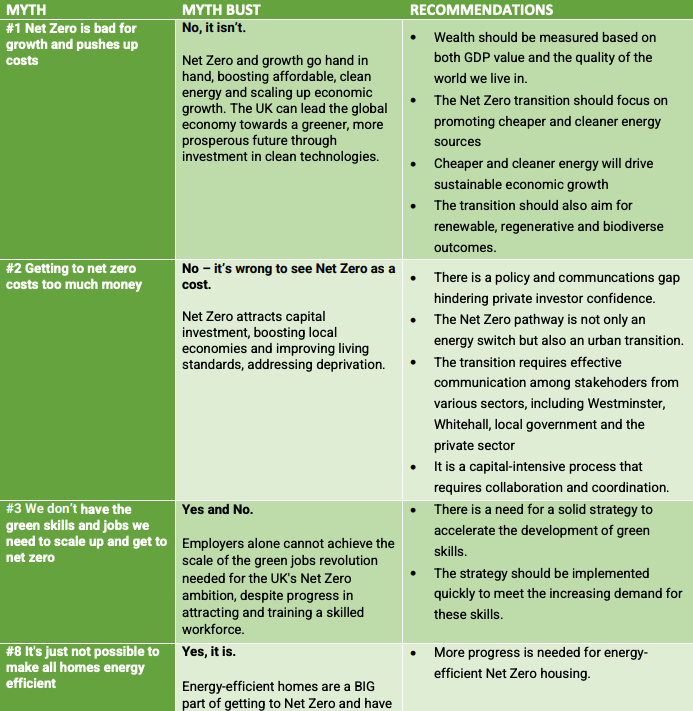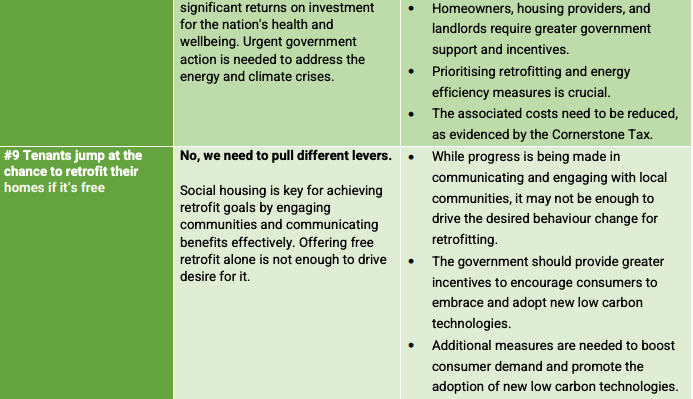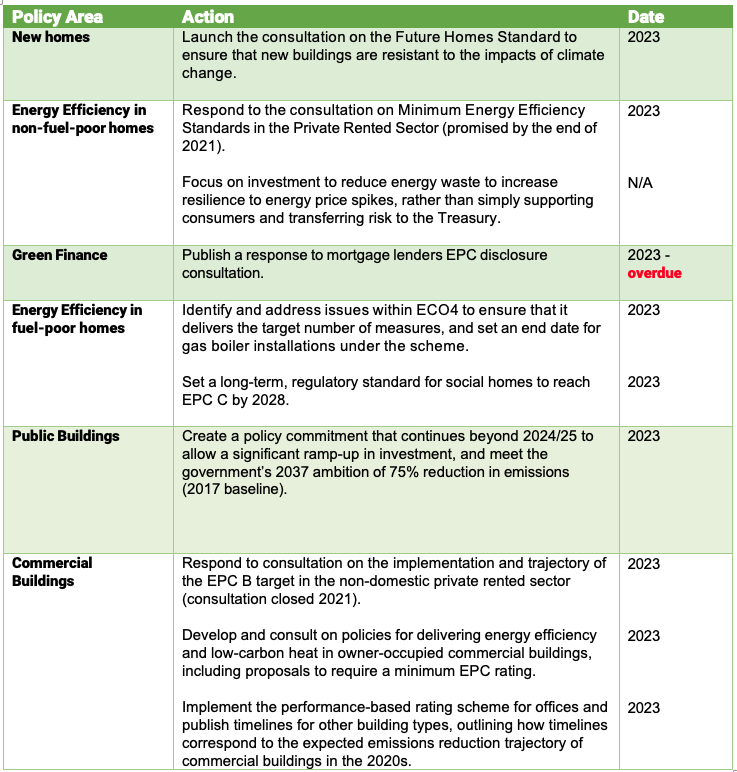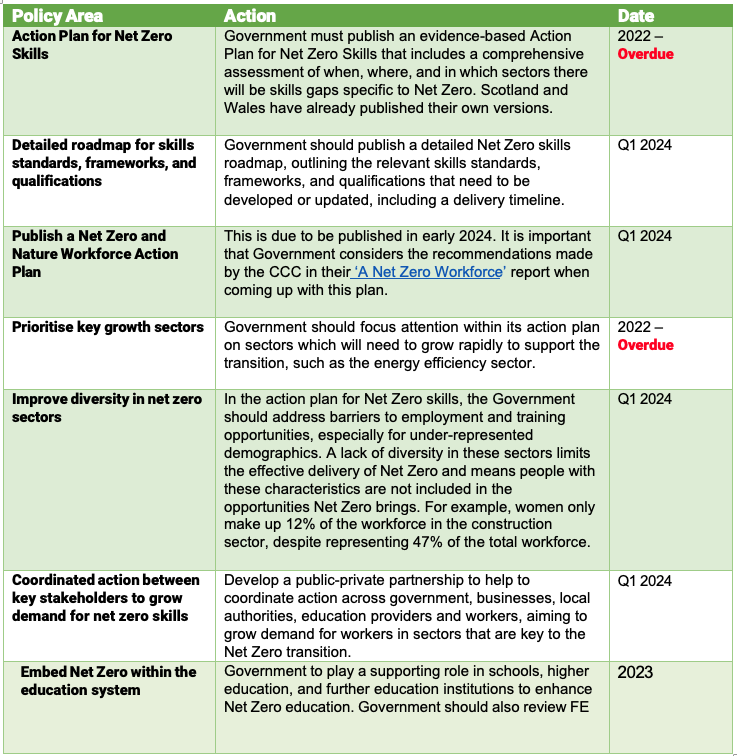
Response submitted by: National Insulation Association
For more information, please contact: info@nia-uk.org
About the National Insulation Association
The National Insulation Association (NIA) represents the insulation industry in Scotland and across the UK with a member base comprised of installers, system certificate holders, and manufacturers who provide a wide range of insulation solutions for homes and buildings. The NIA and its members are fully committed to maintaining and raising standards within the insulation industry.
Domestic Energy Performance Certificate Metric Reform Proposals (MR)
Do you agree with the set of metrics that we propose to display on the reformed EPC?
The NIA agrees with the set of metrics that the Scottish Government proposes to display on the reformed EPC.
The new set of metrics support the need to reduce direct heating emissions, the need to lower residents’ energy bills and tackle fuel poverty, and the need to ensure that the building fabric is as efficient as possible. The proposals provide consumers with a more detailed information breakdown on the performance of different aspects of their home, which will help them to make informed decisions about the best route to improving the energy efficiency of their homes.
It is encouraging to see a separate fabric rating included as one of the headline metrics. A fabric first approach is industry best practice when it comes to whole-house retrofit. It also helps to make the transition to low carbon heat as affordable as possible for consumers. Therefore, it is critically important that the fabric efficiency of homes is clearly displayed on EPCs. This will give consumers a clear of idea of their property’s current fabric performance and how this can be improved, as well as highlighting the importance of adequate insulation to residents. The inclusion and adding weighting given to fabric efficiency on EPCs should help to facilitate muchneeded insulation upgrades to Scottish homes.
The inclusion of a metric for heating system type is also welcome. This means EPCs will more effectively support the transition to low carbon heat. There is very little incentive to install low carbon heating systems within the current EPC framework. Since the EER on current EPCs is based on modelled running costs, cheaper heating systems receive a better rating, regardless of their carbon emissions. Hence, changing EPCs to better incentivise low carbon heating measures, such as heat pumps, is vital if they are to be fit for a net zero future.
Are there additional metrics that you think should be included on the EPC, or metrics that you do not think should be included?
No, we agree with the metrics included.
Considering our proposal to include a Fabric Rating on EPCs, do you think this metric should include domestic hot water heat demand?
No, the NIA does not think that the Fabric Rating should include hot water heat demand. This risks making the metric more complex and potentially confusing for consumers. It could also dilute the focus on fabric measures.
The rationale for including a fabric rating metric is to give residents a clear idea of how well insulated their home is and to drive insulation improvements. By including hot water heat demand (a non-fabric factor), this could detract from the metric’s primary goal – to improve fabric efficiency. While we recognise the importance of limiting heat loss from hot water systems through measures such as insulating the hot water cylinder, it is vital that the fabric rating is not influenced by nonfabric elements, such as type of hot water system. This would detract from the overall efficacy of the fabric rating.
Do you have a view on the way that the Fabric Rating mapped against a scale, for example, how ‘A’ or ‘G’ rated performance is determined?
As current policy commitments and targets are based upon EER bands (in particular Band C), the new fabric rating scale should be aligned with the current EER rating system. This is important to allow for continuity and consistency between different versions of EPCs. It will minimise any confusion that might be caused for businesses and consumers by changes to the EPC framework.
Do you agree with our proposal to give more prominence to the energy efficiency features of the home (such as the depth of loft insulation)?
Yes, we agree with this proposal. Including unambiguous information about the dwelling’s specific energy efficiency features should give residents much-needed clarity. This should help them understand the current fabric performance of their home and allow them to make informed decisions about which measures to take in order to upgrade the property’s energy efficiency.
Non-Domestic Energy Performance Certificate Metric Reform Proposals (MR)
Do you agree with the set of metrics that we propose to display on non-domestic EPCs?
No, we believe that non-domestic EPCs should also include fabric rating as an additional headline metric, as is being proposed for domestic EPCs.
A fabric first approach is the most effective method to carry out whole-building retrofit. This is true regardless of the building’s use. A high level of thermal efficiency is equally important for non-domestic buildings as it is for domestic ones. Adequate insulation could save businesses a significant amount of money on their overhead costs, especially with energy bills at their current high level. Therefore, fabric rating should be clearly displayed on non-domestic EPCs so that building owners are fully aware of their building’s fabric efficiency and what steps they can take to improve it.
The fabric efficiency of non-domestic buildings is also important to ensure that they have a correctly sized heating system. This is particularly important when buildings are installing a new low carbon heating system. For instance, If a heat pump is installed followed by insulation, the building’s heating system output may not be proportionate with its reduced space heating demand and therefore have capital and running costs that are unnecessarily high. The installation of fabric efficiency measures prior to, or alongside, the installation of a low carbon heating system means a smaller, cheaper system can be installed. This is especially important in non-domestic buildings, which often have a significantly larger space heating demand and floor area than domestic dwellings.
In their 2023 Annual Progress Report to Parliament, the Climate Change Committee (CCC) highlighted non-residential buildings as an area of concern, nothing that, “There is a large and increasingly concerning policy gap relating to non-residential buildings.” Hence, it is crucial that the Scottish Government gives the same attention to the fabric efficiency of non-domestic buildings as it does for domestic ones. The best way to reduce the energy use and carbon emissions of non-domestic buildings is to make sure that they are adequately insulated. Thus, a fabric rating should be included on non-domestic EPCs, so that businesses as well as residents are incentivised to improve the fabric efficiency of their buildings.
Are there any additional metrics that you think should be displayed, or any in the proposed set that should not be included?
As set out in our response to Question 6, we believe that non-domestic EPCs should include fabric rating as an additional headline metric.
A fabric first approach is the most effective method to carry out whole-building retrofit. This is true regardless of the building’s use. A high level of thermal efficiency is equally important for non-domestic buildings as it is for domestic ones. Adequate insulation could save businesses a significant amount of money on their overhead costs, especially with energy bills at their current high level. Therefore, fabric rating should be clearly displayed on non-domestic EPCs so that building owners are fully aware of their building’s fabric efficiency and what steps they can take to improve it.
The fabric efficiency of non-domestic buildings is also important to ensure that they have a correctly sized heating system. This is particularly important when buildings are installing a new low carbon heating system. For instance, If a heat pump is installed followed by insulation, the building’s heating system output may not be proportionate with its reduced space heating demand and therefore have capital and running costs that are unnecessarily high. The installation of fabric efficiency measures prior to, or alongside, the installation of a low carbon heating system means a smaller, cheaper system can be installed. This is especially important in non-domestic buildings, which often have a significantly larger space heating demand and floor area than domestic dwellings.
In their 2023 Annual Progress Report to Parliament, the Climate Change Committee (CCC) highlighted non-residential buildings as an area of concern, nothing that, “There is a large and increasingly concerning policy gap relating to non-residential buildings.” Hence, it is crucial that the Scottish Government gives the same attention to the fabric efficiency of non-domestic buildings as it does for domestic ones. The best way to reduce the energy use and carbon emissions of non-domestic buildings is to make sure that they are adequately insulated. Therefore, a fabric rating should be included on non-domestic EPCs, so that businesses as well as residents are incentivised to improve the fabric efficiency of their buildings.
EPC Purpose and Validity (MR)
Do you agree with us that the primary role of the EPC should be to provide basic energy efficiency information for the purpose of comparison and act as a prompt to consider retrofit options?
Yes, we agree.
Do you agree that the validity period of EPCs should be reduced from 10 to five years?
Yes, we agree with this in principle. The energy efficiency landscape is constantly changing as new policies and targets are introduced to drive the transition. The Scottish Government has set a target for all homes to reach EPC C by 2033.1 With the current validity period of 10 years, this means that an EPC carried out today would be still valid in 2033, even though the energy efficiency landscape will look drastically different by then.
Reducing the validity period to 5 years would allow a more up-to-date and greater coverage of EPC data across the housing stock. It would also provide a more accurate picture of the UK housing stock and its energy performance for policymakers, businesses and consumers. The Government.
However, if the Scottish Government is to proceed with this proposal, it must support industry to train new energy assessors and upskill existing workers, as it will be necessary to increase the number of skilled energy assessors to meet the increased demand for EPC assessments. This would also improve the accuracy of EPCs and thereby increase consumer confidence in the reliability of the EPC framework.
This represents a significant challenge for industry and government. Therefore, the NIA would like to see the Scottish Government work with retrofit employers and training providers to widen the provision of retrofit training across the country. The Home Decarbonisation Skills Training Competition has been very successful in England and is now in its second phase.2 When we signposted members towards this latest pot of skills funding, we had interest from Scottish members who enquired about whether Home Decarbonisation Skills Competition funding was available in Scotland (which unfortunately it is not).
There is clearly a demand and need for more subsidised skills funding in Scotland. Therefore, we would urge the Scottish Government to consider introducing a similar scheme to the Home Decarbonisation Skills Training Competition in Scotland, which would enable Scottish retrofit businesses to access subsidised training courses to train existing and new employees, and ultimately grow their businesses. Without more investment in training, we have concerns that there will be severe shortages in energy assessors and other roles key to the decarbonisation of homes. This could limit the practical viability of reducing the validity of EPCs to 5 years, and potentially hinder Scotland from reaching its wider energy efficiency targets.
We welcome any views on the usefulness of our proposals for other relevant policy areas, such as fuel poverty or the delivery of government schemes. Please provide any comments you wish to share.
Based on feedback from our membership, the requirement for installers to be Green Deal certified can represent a barrier to businesses and consumers. There are several reasons why an installer may not be Green Deal certified. For instance, some installers cannot use pre-existing “systems” because they a lot of their business is either architect-specified or needs bespoke solutions for installers. For these installers, it often doesn’t make sense to be Green Deal certified.
However, these businesses often miss out on business unfairly because of difficulty with customers accessing HES funding. Hence, we believe customers accessing HES funding should be allowed to use a Green Deal, Trustmark or NIA registered installer. This would give customers more options as well as ensuring better value for money for homeowners and taxpayers.
Digital and Accessible EPC Format and Content (PA)
Do you agree with our proposal that EPCs should move from PDF to webpage format?
Yes, the NIA support this proposal as it will encourage EPCs to be used more and therefore will support its intended use as a guidance document for investment in home retrofit. The proposed changes will improve the accessibility of the document for readers. Enabling residents to view their EPC on a mobile device will allow EPCs to be viewed by a wider group of people. It will also enable people to view EPCs when they are on-the-go or away from their laptop. It will also allow for a more efficient system of updating the documents as the webpage can be updated with new data more frequently than pdf formats. As stated in the consultation, a webpage format will also reduce additional verification steps making the document more useable for those trying to access information about the properties they live in. The NIA support this proposal as it contributes to making EPCs more accessible and user-friendly.
As well as the format being easier to access, having the EPC on web page format will allow for additional links to be included helping readers to understand the content of the EPCs in greater detail. This is currently a barrier for consumers as the information on EPCs can be hard to follow without additional knowledge. In their letter to Lee Rowley MP, Parliamentary Under Secretary of State for the Department of Levelling up, Housing and Communities, ‘Reform of domestic EPC rating metrics to support delivery of Net Zero’ , the Climate Change Committee (CCC) list several factors that contribute to EPCs being unfit for purpose including the 1-100 rating scale, which does not provide useful information on what steps the consumer should take to improve the efficiency of their home.3 If EPCs were moved to webpage format as proposed, the advice provided can be accompanied by additional links enabling the reader to access supporting information to help them understand the content.
However, these businesses often miss out on business unfairly because of difficulty with customers accessing HES funding. Hence, we believe customers accessing HES funding should be allowed to use a Green Deal, Trustmark or NIA registered installer. This would give customers more options as well as ensuring better value for money for homeowners and taxpayers.
Do you agree with our proposal to improve signposting to further support and advice schemes on the EPC?
Yes. As mentioned above, being able to link readers to external information will support informed decision making on how they should invest in their homes. By directing readers towards existing support, such as existing energy efficiency and retrofit schemes in Scotland, they can see whether they are eligible for financial support, which according to the Energy Saving Trust (EST) is amongst the most common barriers for investing in home retrofit, alongside access to advice and information.4 The NIA support this proposal as this will add an extra layer of support provided through EPCs and will encourage engagement with existing schemes, helping to support the Scottish Government’s target of reducing emissions in homes by 68% from 2020 levels by 2030. Rather than the EPC being a standalone document, it can be used to link readers to information and existing support to help them to realise the retrofit work they are interested in, benefit from the results of an improved EPC rating and contribute to the decarbonisation of the housing sector.
However, it is important that readers understand that whilst EPCs offer advice, they should still get a full survey and retrofit assessment from a reputable installer before getting any work done to their home. This will ensure that they are choosing the right measure for their property and that they understand what is involved including time and cost.
To this end, we would recommend that, as well as linking to EST and HES, EPCs should also signpost customers to where they can find reputable, Trustmark-registered local installers. This is important as for many residents, the next step after having an EPC done is to install retrofit measures. It can be challenging for consumers to know where to start and sometimes speaking to local installers can clarify what work is available and at what cost. Consumers should be encouraged through the advice on their EPC to receive multiple quotations on the cost of the work where possible. By signposting to a trusted site this can help to simplify the retrofit process for consumers and help them take the next step to upgrading their home.
By directing consumers to a site where they can find high-quality, local installers, it would also reduce some of the burden on advice services, thus reducing the risk that a bottleneck could be created through massed calls to EST and HES, for example. For customers looking to install energy efficiency measures of the back of an EPC, it might be helpful to direct them directly towards businesses who can install the measures they want.
Do you agree historical EPCs should be publicly accessible on the EPC register (while clearly marked as historic)?
Yes, the NIA support this proposal as it will allow new homeowners to view and understand previous EPC ratings allocated to the property and any historical retrofit works that have taken place at the property to get to the current EPC. This proposal will also help local authorities to understand the common issues and solutions in housing in their local area. The effective use of data is vital to give local authorities an in-depth and detailed picture of their housing stock. This will allow them to plan more effectively for council-led retrofit programmes and create local decarbonisation strategies that are tailored to the local housing stock.
This data may also be useful for understanding local skills gaps through the identification of the most common work needed in homes in the area and the availability of local installation companies. The NIA works closely with contractors, suppliers and installers to identify ways to address the UK wide green skills gap with localised solutions being at the forefront of overcoming this issue in order to reach Net Zero.
Do you agree that the EPC register should be accessible by API?
Yes, the NIA support the proposal to include the EPC register in an Application Programme Interface (API) to allow for key stakeholders to access historical EPC data throughout the year. These key stakeholders could include homeowners, local authorities, industry representatives, research organisations and policymakers. The NIA believe this kind of data transparency can support key stakeholders in understanding how to improve the EPC rating of homes through access to information, which will ultimately support the transition to Net Zero.
EPC Auditing and Assurance (PA)
Do you agree with our proposals to review and update the auditing and assurance requirements for EPCs in Scotland?
Having accurate EPCs is fundamental to the decarbonisation of the housing sector as they are often the starting point from which consumers make decisions on what retrofit works to carry out on their properties. On principle the NIA agree with the proposed changes to the auditing process as smart auditing would allow for automatic triggers for EPCs meeting certain criteria, thereby enabling homes to be highlighted where urgent improvements are needed. This would be particularly useful for identifying the hardest to treat and worst performing homes. However, there are some questions on how this would work in practice in terms of informing homeowners and arranging assessors to visit the properties in question if this is to be part of the process.
Please detail any additional assurance activity that you think would be appropriate to enhance the accuracy and reliability of EPCs.
The NIA believe prioritising energy efficiency improvements to the building fabric are the most effective ways of increasing thermal comfort, reducing energy loss from properties and reducing energy consumption as properties require less energy for space heating. Therefore, EPCs should advise households to invest first in insulation measures before moving to heating system upgrades according to a fabric-first approach. More widely, following the fabric-first approach has the highest benefits for decarbonisation of the housing sector as insulation measures help to reduce energy consumption and enable an affordable switch to using low-carbon heating systems such as heat pumps.
Consultation Questions: Legislating for EPC Reform and Timeline (PA)
Do you have a view on our timeline for reform implementation?
The NIA agree with the timeline proposed as it allows a grace period for stakeholders and homeowners to become familiar with the changes. The time period aligns with the introduction of other regulations in Scotland including the Energy Performance of Buildings Regulations. However, there is also an urgency to the introduction of policy changes that will serve to encourage investment in the decarbonisation of the housing sector, which these changes are likely to do, therefore we encourage the Scottish government to implement the reforms as quickly as possible.













